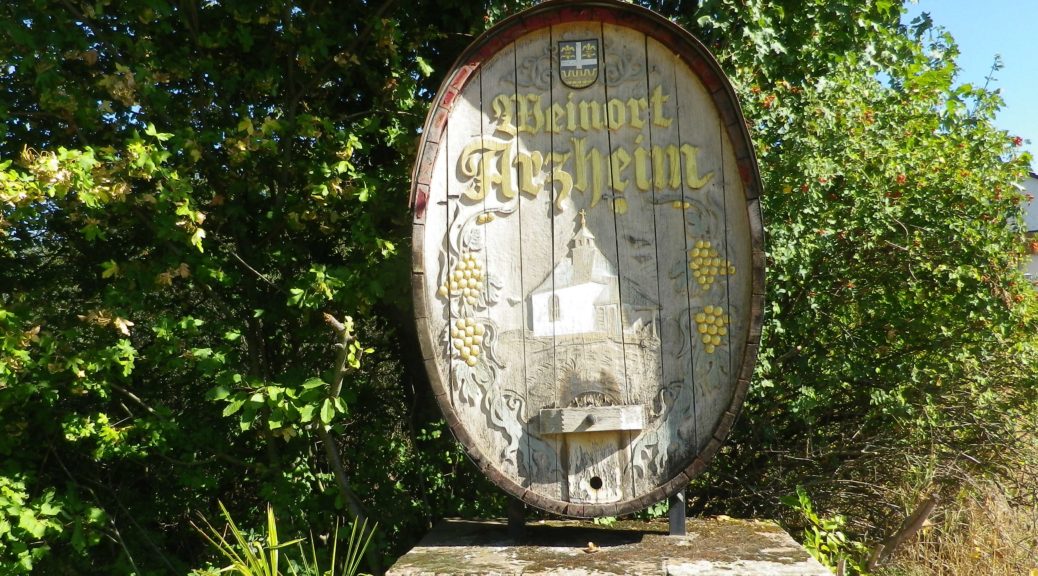What I Learned:
The Pfalz Wine Region has a long history of wine making. The pressing room and vats at the Weilberg Roman Winery (Römische Weingut Weilberg), near Bad Duerkheim, and the implements found throughout various sites all along the Deutsche Weinstrasse, testify to this long history.
The tradition continued with the establishment of regional monasteries, such as the ones in Klingenmuster and Wissembourg dating to the 600s. This was especially true along the Pfalz’s Suedliche Weinstrasse. Wissembourg was a rich and powerful monastery in its day. In today’s Edesheim, the abbey owned the “Villa Auduino,” which consisted of an agricultural manor house and two churches. In Nussdorf, the Monastery of Fulda (far to the north) owned its own manor house. These places were important to the monks, not just for providing food products, but also for their wines, which they needed for liturgical services.
Hence, in the Suedliche Weinstrasse district, winemaking has been an important economic activity for about 2000 years. Not only has this area had an uninterrupted history of winemaking, it also continues to modify and improve its traditions over time.
Siebeldingen’s Institut fuer Rebenzuechtung (Institute for Grape Cultivation) Geilweilerhof (the building itself a former cloister) is an invaluable resource in this regard. The institute maintains databases on grape varietals, and has test cellars to make and test wines from new varietals. This all supports its main function: to develop new varietals, genetically resistant to climatic changes and pests.
Some of its older creations will be familiar to lovers of German wines: the white varietals of Morio-Muskat and Bacchus, and the red varietals of Domina and Regent (two of the most flavorful and powerful German red wines, IMHO). One of the newest grapes to come onto market as wine is the white Calardis Blanc, a cross between a Bacchus and Seyval Blanc, and a Seyve Villard. (Finding a bottle will be a challenge for a few years to come, so head to the Institute’s wine shop in Siebeldingen for now!)
Over 125 varietals are planted in the Pfalz wine region, to include the ones listed above! But only half a dozen or so make up over 60 percent of the plantings. Riesling has always played an important role, but more so in the northern part of the Pfalz wine region. Mueller Thurgau is also an important white varietal, especially so in the south. Weissburgunder (Pinot Blanc) is another white wine grape that is planted here, although in far smaller quantities. As for the red varietals, there is Dornfelder, the most widely cultivated red wine grape locally. As a percentage of red wine grapes grown, it has overtaken the traditional favorite: Portugieser. Spaetburgunder, aka Pinot Noir, represents a full 7% of the grapes planted, and is gaining in popularity.
What I Tasted:
2017 Gruener Silvaner, Ortswein, Trocken, Weingut Voegeli (Wollmesheim): A dry white wine with a medium yellow gold color; a mineral nose, with herbal, grass, spice and slight pear flavors; medium acidity, with a tangy finish.
2017 Chardonnay, Lagewein, Trocken, Weingut Voegeli: A dry white wine with a medium white gold color; a peach, honey and mineral nose, with peach, pear and floral flavor; medium acidity, with a smooth finish.
2016 Riesling, Lagewein, Trocken, Weingut Voegeli: A dry white wine with a medium gold color; a slight mineral and turpentine nose, with spice and green apple flavors, medium plus acidity, with a crisp, tart finish.
2012 Weissburgunder Sekt: Weingut Wilhelmshof, (Siebeldingen): A sparkling white wine with lively, persistent perlage and medium gold color; a powerful fruity nose, with powerful fruity grape and white stone fruits flavors, a medium and sweet finish.
